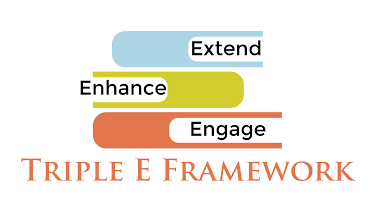When creating an eLearning course from scratch or if you are evaluating your current course, it is essential to ensure that you have selected the most appropriate learning materials. This is probably the single most important thing you can do to make any instructional lesson or course a success.
With the vast amount of continuously developing digital tools available in online learning, a new level of complexity is being added to learning when compared to traditional face-to-face classrooms. One of the more complexities is assessing how the selected materials are impacting your learners’ abilities to grasp the learning objectives and course goals.
Despite the fact that technology helps learners learn, there is often a lack in theoretical practice from instructional designers and eLearning instructors when it comes to measuring if and how learning is actually occurring.
When selecting learning materials, it is important that instructors understand the value in using frameworks when it comes to selecting appropriate media, materials, and tools.
Ask Yourself:
- What instructional method would work best for this group of learners?
- What type of media (text, still images, audio, video, etc.) would best compliment the instructional methods?
- What materials should learners have supplied to them to assist with subject mastery?
Popular frameworks that you can use when selecting your own materials for your online course.:
- TPACK Framework
- TIP Model
- The 4 I’s Model
- The Triple E Framework
The TPACK Framework
By having a better understanding of your own learners’ knowledge, instructors can better facilitate student learning. The Technological Pedagogical Content Knowledge Model (TPACK) is a framework that can help instructors with this process.
This framework requires you to examine your knowledge of content, pedagogy, and technology skills and determine how all three of these areas work together instead of individually. The TPACK model represents understanding content with technology, using pedagogical techniques with technologies to teach content, and knowing what concepts are difficult to grasp and using technology to aid that process.
The heart of the TPACK framework is the complex interplay of three primary forms of knowledge: Content (CK), Pedagogy (PK), and Technology (TK).
Technology Integration Planning (TIP) Model

This model is helpful for teachers when they are deciding on which best practices, strategies and materials to use for a lesson/activity that integrates technology. It has three (3) phases that include seven (7) steps.
During Phase 1, teachers look at the learning needs of their students to determine which strategy/method/practice they will implement.
Step 1: Relative Advantage
Step 2: Tech-PACK
During Phase 2, teachers create their plans for instruction delivery, ways to assess their students, and an environment supportive of technology integration. (3 steps)
Step 3: Objectives & Assessments
Step 4: Integration Strategies
Step 5: Instructional Environment
During Phase 3, the teachers continue to plan by analyzing and reviewing lessons and activities that have been delivered.
Step 6: Analyze
Step 7: Revisions
The 4 I’s Model
The 4 I's Model is an excellent instructional design model that helps to ensure that your design choices consider four essential categories: innovate, integrate, inter-connect, and involve. These four categories are designed to not only maximize the potential of technology tools themselves, but also to create a well-rounded and pertinent learning environment.
Triple E Framework

The Triple E Framework attempts to define effective digital tools into a course while supporting the learning goals. The framework is based on three components:
- Engagement in learning goals
- Enhancement of learning goals
- Extension of learning goals
While these three terms are often used interchangeably, they are distinct, and it’s important to define and show examples of what makes each level unique.
Learn strategically how to implement the Triple E Model for selected materials and tools in your own online course in the eLearning and Instructional Design for Beginners Community.
JOIN THE
eLearning and Instructional Design for Beginners Community
- In-depth courses & training
Access my rapidly growing library, attend monthly live training & accountability support groups
- Exclusive tools & members-only discounts
Tools, templates, downloads, checklists and more - plus receive special perks & discounts
- Supportive community & network
Feedback and support from fellow instructional designers, career-driven business owners, and experts who will keep you on track
Get Your Software Toolkit for Instructional Designers
Tools & processes that will help you plan, build, and grow your instructional design career and freelance business.



